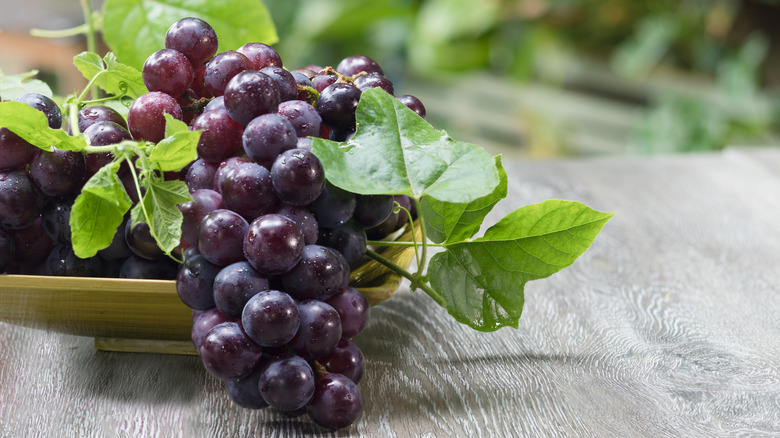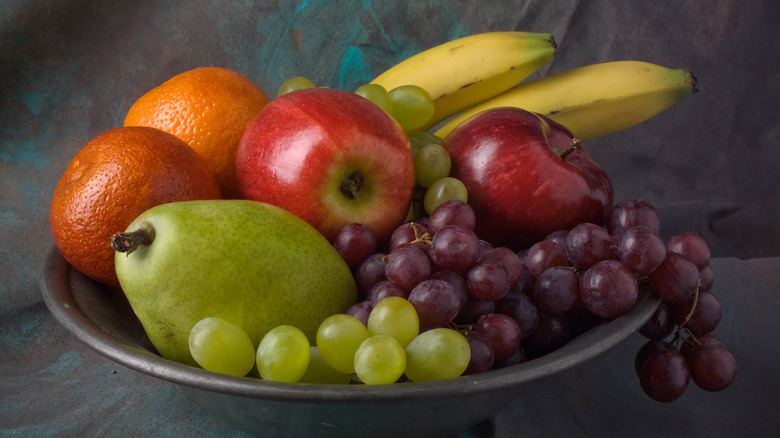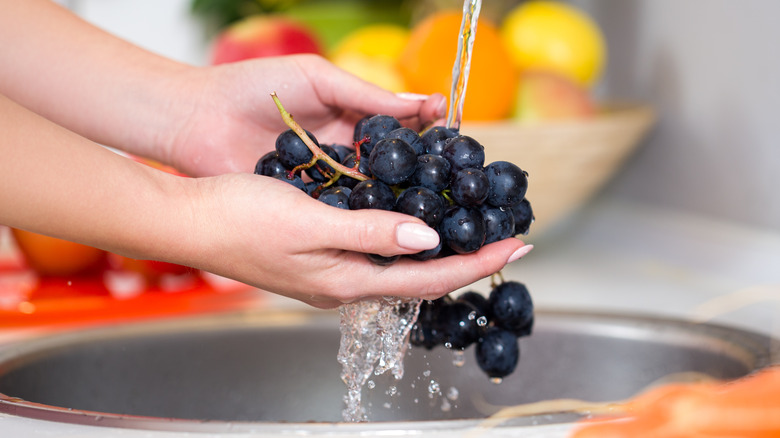Why You Should Always Store Grapes On The Stems
Bringing home a beautiful bunch of grapes can feel almost decadent. You're anxiously looking forward to some delicious grape and cheese snacks, and you have a delightful candied Waldorf salad in mind for a later date. But your immaculate produce only stays fresh for so long, and you may start to wonder how to maintain your grapes' quality until they have the opportunity to explode their sweetness onto your taste buds. If you want to store grapes for the lengthiest amount of time possible, there are a few things to keep in mind, but the most important thing you can do to extend the life of your grapes is to leave them on the stem.
When you remove a grape from its stem, a sizeable hole is left on the skin, and air will find its way into that hole. Storing grapes with the stem attached can prevent that air from entering your grape and extend its shelf life. If you remove the stem before you store grapes, they may only last 5 to 7 days. With the stem attached, stored grapes can last 2 to 3 weeks in the fridge; however, this is under ideal conditions. Leaving the stem attached while storing grapes is essential, but there is more you can do to control your grapes' plump and juicy nature.
Can you leave grapes in a fruit bowl?
Simply leaving them on the stem isn't enough to keep grapes at their freshest. While it may be tempting to enhance the aesthetics of your kitchen by creating a fancy fruit bowl that looks like it belongs in a Roman palace, it will not help the freshness of your grapes. Storing grapes on the counter at room temperature will only give you a 2 to 4-day window. The best place to store grapes is in the refrigerator. They do best in high humidity, so the bottom crisper drawer in your fridge is ideal. You also want to place them in a ventilated container — the plastic bag you likely purchased them in is a good option.
Stored grapes need cold, humidity, and good air circulation for the best shelf life. If you have a particularly sizeable bunch of grapes, divide it into smaller clusters before storage. Air will circulate more efficiently this way, which is significant because poor air circulation can advance mold growth and rot. While dividing up these new bouquets, watch for any signs of sponginess. If you see a particular stem with several sub-par grapes attached, remove the whole lot attached to that stem to separate it from the grapes that are healthy and crisp.
Don't wash grapes right away
Another way to maintain your grapes' impeccable condition is to forego washing them until you're ready to consume them. You may have noticed a thin white film on grapes in the past. This protective layer over the skin is called the "bloom," and washing it away will prematurely make your grapes more susceptible to spoilage; grapes are best washed just before eating.
Some grape varieties keep longer than others, so even with the best-laid plans, grapes will sometimes go bad faster than you hope. Grapes on the verge of spoiling will start to look shriveled, and you may see mold or browning on the stem. You can always store grapes in the freezer if you have more than you can use in a short window. For freezer storage, this is where you will want to remove them from the stem. Wash them thoroughly and pat them dry to remove any excess moisture. Layer them on a sheet pan and freeze for about an hour until they're hard, then transfer them to a freezer-safe bag. Frozen grapes can last up to a year, and they're a great way to jazz up your favorite cocktail with some fruity ice cubes. But if you want to experience a decadent burst of sweetness with every bite, eat your grapes right off the stem.


